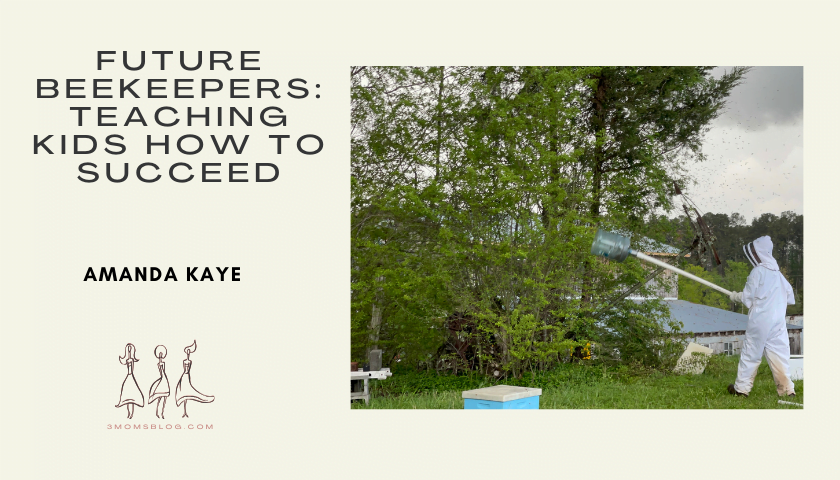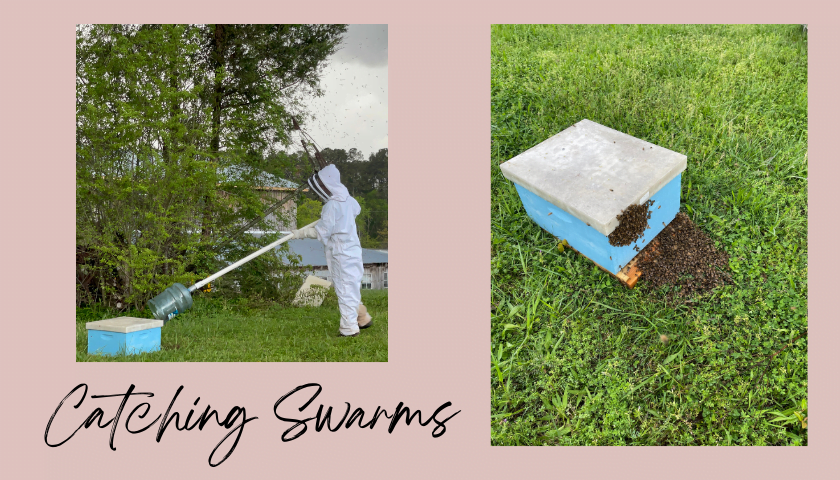It is honey bee swarm season in East Tennessee. If you’ve read my post, Beekeeping 101 with an Accidental Beekeeper, you know we started our beekeeping journey by catching swarms from a honey bee tree in our yard. Our honey bee tree is a walnut tree with a large hollow area in the trunk. A limb fell off the tree a few years ago. This created the perfect opening for bees to fly in and out and became a great source of honey bee swarms.

Each year we have honey bee swarms come out of the walnut tree. Bee swarms usually land within 100 feet of the hive from which they originated. The swarms will rest there while the scout bees go and look for their new home. The swarms we have caught have all been within 15 to 20 feet of our bee tree or hives.
In preparation for swarm season, we placed empty hive boxes around our property, hoping the empty boxes would attract the new swarms. We also frequently check trees and fence posts that bees could cluster on. We haven’t had any bees go into our empty boxes but by having them ready we could quickly gather the equipment to catch the swarms.
watching for swarms
My oldest, Thomas, has been helping with the bee hives for the last two years. He is usually one of the first to spot a swarm. When he saw a huge group of bees flying out his bedroom window he knew it was a swarm looking for a place to land. He watched them land on a small tree. Once they had landed he came down to tell me that we had a swarm to catch. We gathered a box and got to work.
A few days later on a rainy morning, Thomas noticed that the swarm we had caught was clustered under the box we had them in. He went out to check the box and all the bees had moved out. Thomas, Kaye, and I suited up and went to recatch them. We changed up our box arrangement and got them back into a box.
Walking to the house, we noticed another swarm up high in a pear tree. This was going to be a more difficult catch. We have a long pole with a 5-gallon water bottle taped to the end to catch swarms above our heads, but this one was higher than we could reach.
Thomas helped me get a pallet and cage on the front of the tractor so I could pick him up with the front-end loader. He was able to reach part of the swarm but still couldn’t get it down. We aggravated it for a while and realized this wouldn’t work, so we decided to go in the house for lunch and hope they would come down to one of our empty boxes.

trying again
While we ate lunch Thomas looked out and saw that they had moved into a cinder block that we use to weigh the top down on one of our hives. We finished lunch and suited back up to see if we could catch them this time. We placed a piece of cardboard on the ground to sit the empty box on, carefully moved the cinder block to the cardboard, and gently scraped some bees off next to the entrance. Once we had several bees going into the hive box we left them alone to see if the others would follow.
A few hours later, we went out to check and there was just a small clump of bees left inside the cinder block. I gently reached in and scraped the bees onto the cardboard in front of the entrance. They all immediately started walking into the hive.
helping our beekeeping group
Later that afternoon, our mentor texted our bee group that he was out of town and had swarms he wasn’t home to catch. I called and offered to capture them for him. He told me where the swarms and his extra equipment were located. Brett, Thomas, and Kaye went to corral the swarms. One of the swarms was about 30-40 feet up in the top of a cedar tree. Brett decided that one was out of their reach and moved on to the next swarm. This one was much lower, and he was able to catch it.
The next day, our mentor asked if we could catch another swarm. I took Thomas and Kaye to capture this one. It was in a cedar tree close to his hives; we added an extension pole to his catching device. After several scoops with the catcher, it looked like most bees were moving into the hive. We left it hoping the rest would come down to the box.

turning it over to the kids
A few weeks into this year’s swarm season, I developed an anaphylactic reaction to bee stings. Read more about that adventure in my post, Dangerous Bee Sting Allergy Symptoms You Need to Know. Once it was apparent that my reaction had become anaphylactic, I “retired” from beekeeping. Thomas, Kaye, and Brett now handle everything with our hives.
Thomas and Kaye caught two more swarms by themselves. One landed a few feet off the ground in an apple tree, and the other was clustered on a low branch in a walnut tree. I watched and gave tips from safely inside the house.
The kids enjoy the responsibility of taking over our beekeeping journey. In addition to catching swarms, they also perform hive checks and maintenance.
Would you like to incorporate bee-themed learning into your homeschool? Download this FREE Montessori-based “Bee Learning Pack!”

4th of July Beekeeping Breastfeeding Budgeting Childhood Allergies Christmas Culture/Geography/History Doctor Visits Encouragement Food Allergies Free Montessori Printables Free Printables Funschooling Gardening Gluten-Free Grain-Free Home Management Homeschool Curriculum Homeschool for Free Homeschool Organization Homeschool Planning Homeschool Printables homeschool transcript Humor Infant Kids Birthdays Language Arts Meal Planning Montessori Home Montessori Homeschooling Montessori Parenting New to Homeschooling Pets Positive Parenting Practical Life Printable Planners Recipe Recipe Cards Science Summer The Thrifty Widow Toddler Unschooling Vegan Youth sports




